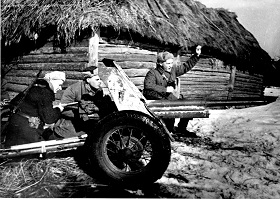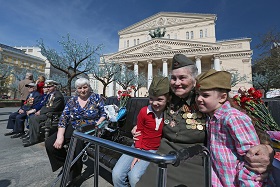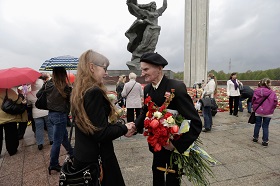The post-Soviet years have been a watershed for newly independent states in establishing traditions and shaping the historical memory of the Second World War. In many of these countries, this memory is clearly different from that in present-day Russia. This is particularly true for the former Soviet republics which were occupied by the Germans during World War II or which witnessed fierce combat. In a number of post-Soviet states, WWII is no longer seen as an unambiguous battle of good against evil, or of defender against aggressor.
Victory Day revised
This is just as true for Ukraine. Already in the early post-Soviet period, a tendency emerged towards changing the perception of the war, which then became particularly noticeable after the Orange Revolution. Today, in the wake of the second Maidan and developments in Crimea and in southeast Ukraine, the perception of Victory Day has become another dividing line between the two countries.
The current Ukrainian authorities have tried to build a new vision of Victory Day in which Ukraine’s losses were truly colossal – a total of 9 million people, according to the latest estimates of experts. This figure includes fatal casualties suffered by Red Army soldiers (2.4 million), by Soviet partisans and militiamen (0.2 million), by Ukrainians fighting in the ranks of military units of other states and by paramilitary groups from the Ukrainian Insurgent Army (UPA) (0.3 million) as well as losses resulting the migration of Ukrainian residents from the USSR (1.7 million).
Civilians made up half of the total number of Ukrainian victims of the war, amounting to 4.4 million people. Ukraine suffered huge losses in terms of logistics, as the Germans considered the republic as a source of resources, not to mention the fact that Ukraine witnessed fierce battles and large-scale operations, which largely determined the outcome of the conflict on the Soviet-German front.
The celebration of Victory Day on May 9 in Ukraine is a tradition inherited from the Soviet era, when this date was made a national holiday in 1965. In 2000, the Law of Ukraine “On perpetuation of the Victory in the Great Patriotic War of 1941-1945” legitimatized this tradition in the country. According to opinion polls from 2013, more than 80 percent of Ukrainians considered Victory Day to be a festive occasion. Today, however, the nature of celebration is undergoing dramatic changes.
“Ukraine will honor the veterans of the Great Patriotic War on May 9 and May 8 will be a remembrance day of the victims,” said Ukrainian President Poroshenko in an interview with ICTV. “May 8 is a day of remembrance, we must bow low before them; both my grandfathers fought in the war… I honor their memory and will honor May 8. May 9 is a day of venerating those who are alive, and we must honor the veterans who gave everything they had to ensure the victory… May 8 and May 9, May 9 remains. May 8 and May 9 unite the country,” said Poroshenko.
In fact, the President’s position offers a moderate interpretation of the concise official concept of celebrating Victory Day in contemporary Ukraine. In addition to these changes to the interpretation of the holiday, the perception of the date of the beginning of the war is undergoing substantial changes as well. It has been proposed that the start date was not June 22, which in Russia is considered a day of mourning and remembrance, but September 1939, when western Ukrainian lands were occupied by the Red Army and then integrated into the Ukrainian Soviet Socialist Republic. A particular emphasis is laid on the fact that in 1939, the Soviet Union pursued a policy agreed upon with Germany in Central Europe, following the signing of a non-aggression pact between Nazi Germany and the Soviet Union in August 1939.
Victory Day with a national flavor
What accounts for this sudden change in the format of Victory Day celebrations? The reason is certainly the desire not only to get rid of the ideological influence of the Soviet past as soon as possible, but also to break spiritual ties with Russia. This great May holiday has been a major component of common historical memory, and its singular interpretation has played an important integrating role.
Today the Ukrainian authorities and a large part of Ukrainian society see May 9 as a holiday, which Russia uses to promote its ideology, expansionist policy and revival of Soviet values. Therefore, the rejection of the Russian format of celebrating Victory Day is considered by the Ukrainian leadership to be a priority.
The Ukrainian authorities have adopted the only possible track available for them under the current conditions. Taking into account the fact during the war, a part of the population supported the nationalists and fought in the ranks of the Ukrainian Insurgent Army, while many more people fought in the ranks of the Red Army and of the guerrilla movement as well as simply resisted the aggressor within their powers, the contemporary idea of the holiday shifts the emphasis of the memory of war from victory onto tragedy. The creators of this concept believe that this interpretation will help unite Ukrainians, strengthen their statehood and smooth out differences between people who fought in different camps during the war.
It is memory and grief that are put to the fore, and an emphasis is being laid on the veneration of the dead rather than on the military component. The authorities are trying to evade such notions as “the victorious people,” “one war – one victory,” “a great feat of the people”, etc. Instead personal tragedies of individuals are being pushed to the foreground. Kiev is seeking to occupy a detached and neutral position on the issue of the war, rather than to celebrate May 9 as the victory of good over evil, alleging as its reason the claim that this approach will help unite the Ukrainian people.
Thus, the recommendations of the Ukrainian National Memory Institute note that World War II was another national tragedy for Ukraine, as Ukrainians, being deprived of their own state, were forced to fight for someone else’s imperial interests and kill other Ukrainians. It is pointed out that a special emphasis should be laid on the particular contribution of Ukrainians to the defeat of Nazism, making no distinction between the soldiers of the Red Army and the Ukrainian Insurgent Army, as well as ethnic Ukrainians, fighting in the ranks of other participants of the anti-Hitler coalition (the Polish, American, Canadian and other armies).
However, despite the establishment of the second Victory Day on May 8, which is celebrated in Europe, and the introduction of the poppy as the holiday’s new emblem, the Ukrainian leadership cannot quickly replace May 9, realizing that canceling May 9 completely could ignite protests and divide the society even further. The process of de-communization and the adoption of this law, which has not yet been signed by President Poroshenko, makes possible unrest and further divides more than likely. Despite the fact that the law’s wording is markedly different from what Ukrainian radicals have insisted on, its provisions are opposed by many citizens, especially by the older generation and particularly in eastern Ukraine. In addition, there is always the risk of carrying the process to the extreme. Ukrainian art and culture of the Soviet period were ideologically biased, but many pieces of art from that period are still of significant artistic and cultural value.
Does new Victory Day unite?
This new interpretation of the holiday, focused on uniting people in tragedy, is a somewhat serious challenge to the traditional perception of Victory Day, as it offers a more acceptable alternative to the ideas of Ukrainian radicals, who strive for a quick imposition of their values and their heroes on the people across the whole country, something that is no more that wishful thinking. This will only lead to a further divide.
The new interpretation of the holiday will gradually erode the Russian perception of the day, and turn it into an element following the pan-European trend. The Ukrainian authorities appear to be trying to non-contentiously unite the Soviet-Russian and the European ideologemes, although there are certain forces in society who are interested in maintaining such a conflict.
Indeed, regardless of the watered-down interpretation by the president, the new perception of Victory Day raises many questions.
First, there are forces in Ukraine who seek not to reconcile society, but to ensure the victory of one part over the other and who hate those who have a different point of view, even if the latter make up a vast majority. “For more than 20 years, we have spared the feelings of those who could have been hurt, and that’s quite enough,” said Vice-rector of the Ukrainian Catholic University in Lviv M. Marinovich, commenting on the de-communization law. Can such a position lay the groundwork for civil harmony? It definitely cannot.
Second, the idea of reconciliation and the denial of the Nazis can hardly go alongside with a glorification of the Ukrainian Insurgent Army, which is being praised by the Ukrainian President for its fight against Nazism, although the UPA had nothing to do with this battle. In contrast to UPA punitive expeditions against Polish villages during the Volhynia “de-polonization” and other fighting against guerrillas, there is no evidence of any major clashes between the Germans and UPA units.
Third, given the current political course of the Ukrainian leadership, the coexistence of the two dates – May 8 and May 9 – will inevitably reduce the value of May 9 and enhance the significance of May 8 as veterans of the Great Patriotic War pass away.
***
One can hardly argue that history in general highlights new key points over time. Of course, Victory Day cannot be perceived the same way in different countries, which Europe illustrates perfectly well. However, despite certain marginal examples, the European countries (in the first place those located in the core of Europe) cherish the memory of their liberation from the Nazis by Soviet troops. Recently in Russia, at least sporadically and not on an official level, a tendency has emerged of diminishing the role of the Allies in the victory over Nazism, which was truly enormous both in terms of assistance to the USSR and of direct warfare in Africa, Italy, and Western Europe.
Of course, the celebration of Victory Day in many European countries will not be similar to what it used to be during the existence of the socialist bloc, but words of gratitude and apology (for example, from Germany) are expressed even today, and by the most high-ranking officials as well. This is largely due to the fact that the political elite is aware of its responsibility in preventing the dilution of the memory of the horrors of Nazism as a kind of safety cushion against a further strengthening of nationalism and right-wing radicalism.
As for Ukraine, the risk of obliviousness is still present. Despite the declared adherence to strengthening unity, there is a danger of contrasting May 8 with May 9 on the part of the radical anti-Russian political forces. In addition, a significant share of Ukraine’s population continues to perceive Ukrainian veterans as soldiers of the Soviet Army, rather than fighters for independence. Given the contrasting nature of celebrating Victory Day on May 9 in Russia and Ukraine, as well as the gratitude expressed by President Poroshenko to the fighters of both the UPA and the Red Army for getting rid of fascism, many fail to accept this new conception by Kiev. Moreover, the family tradition and a vast majority of works of art (movies, literature, and theater) praise the common victory, while it takes time for the new concept to gain ground in society and win over the minds of the people. The current authorities may simply not have such time at their disposal.



.jpg)




